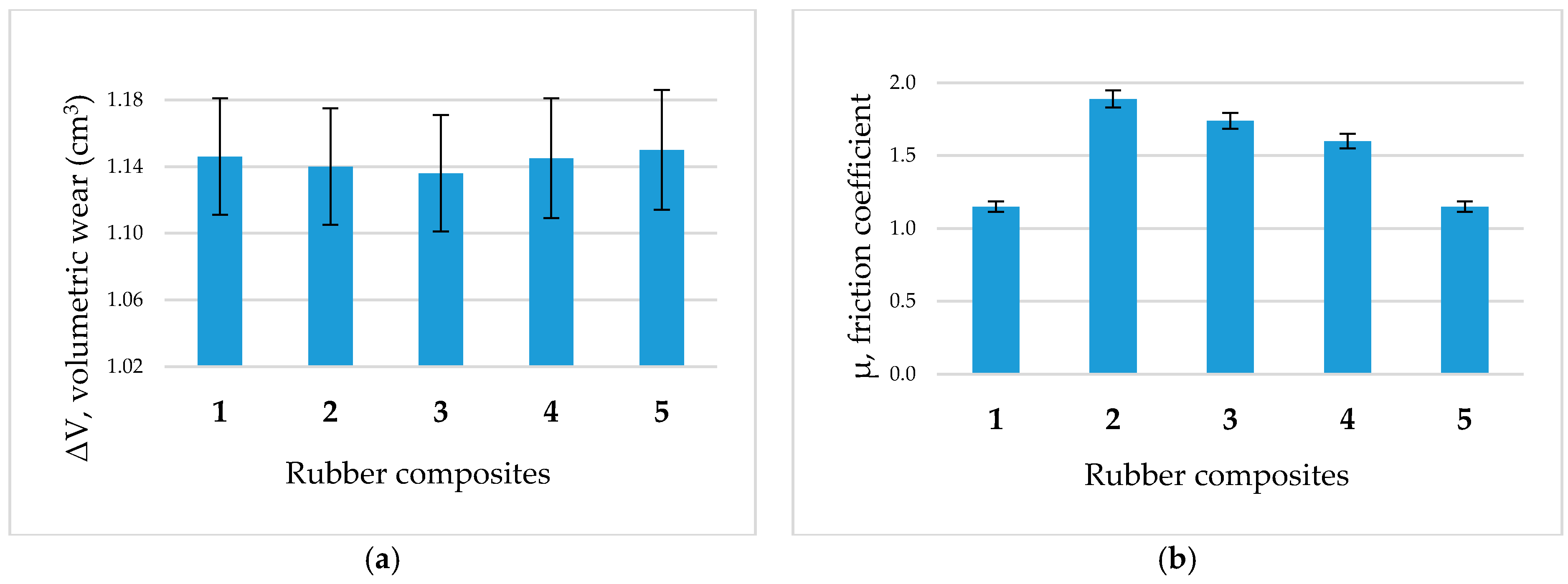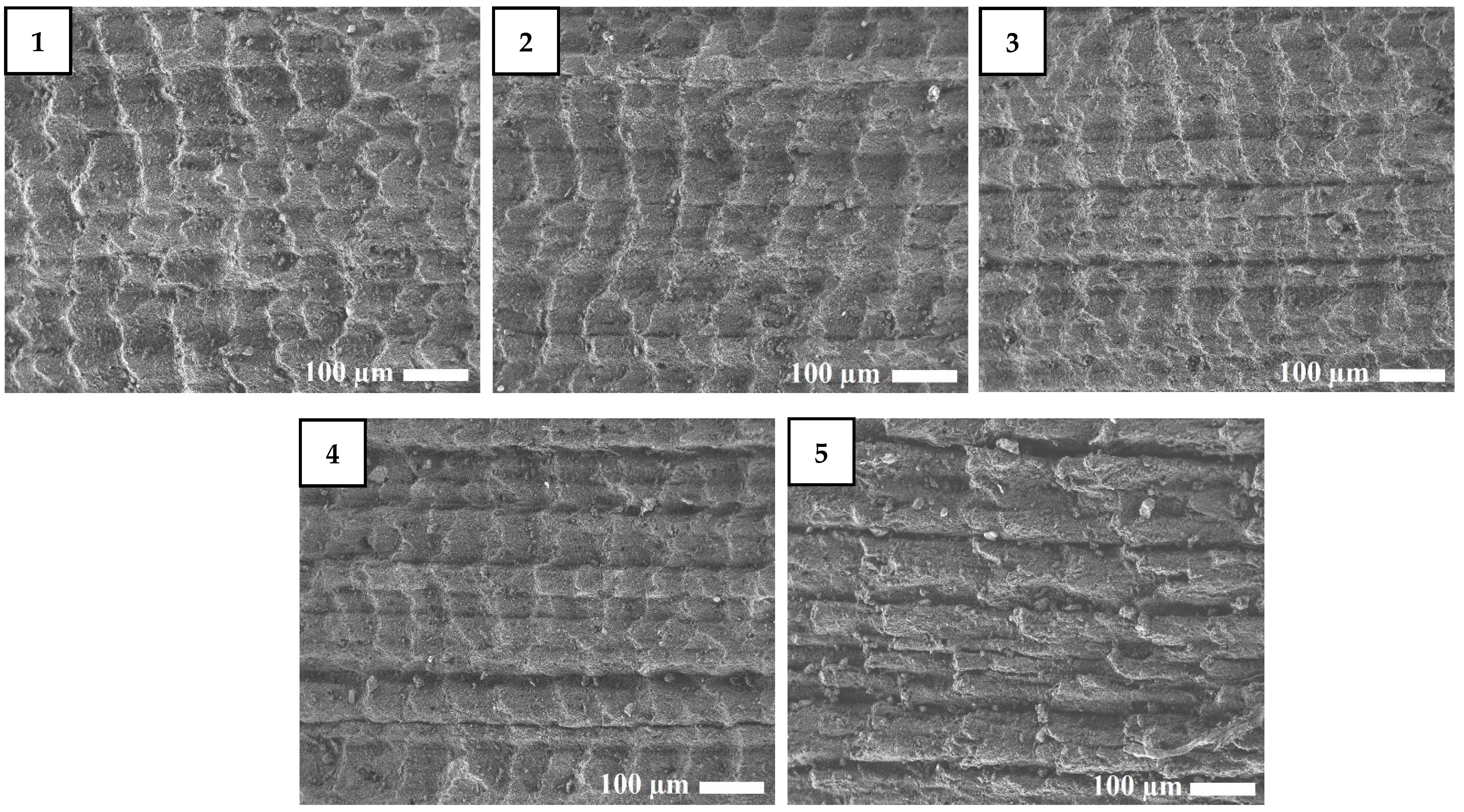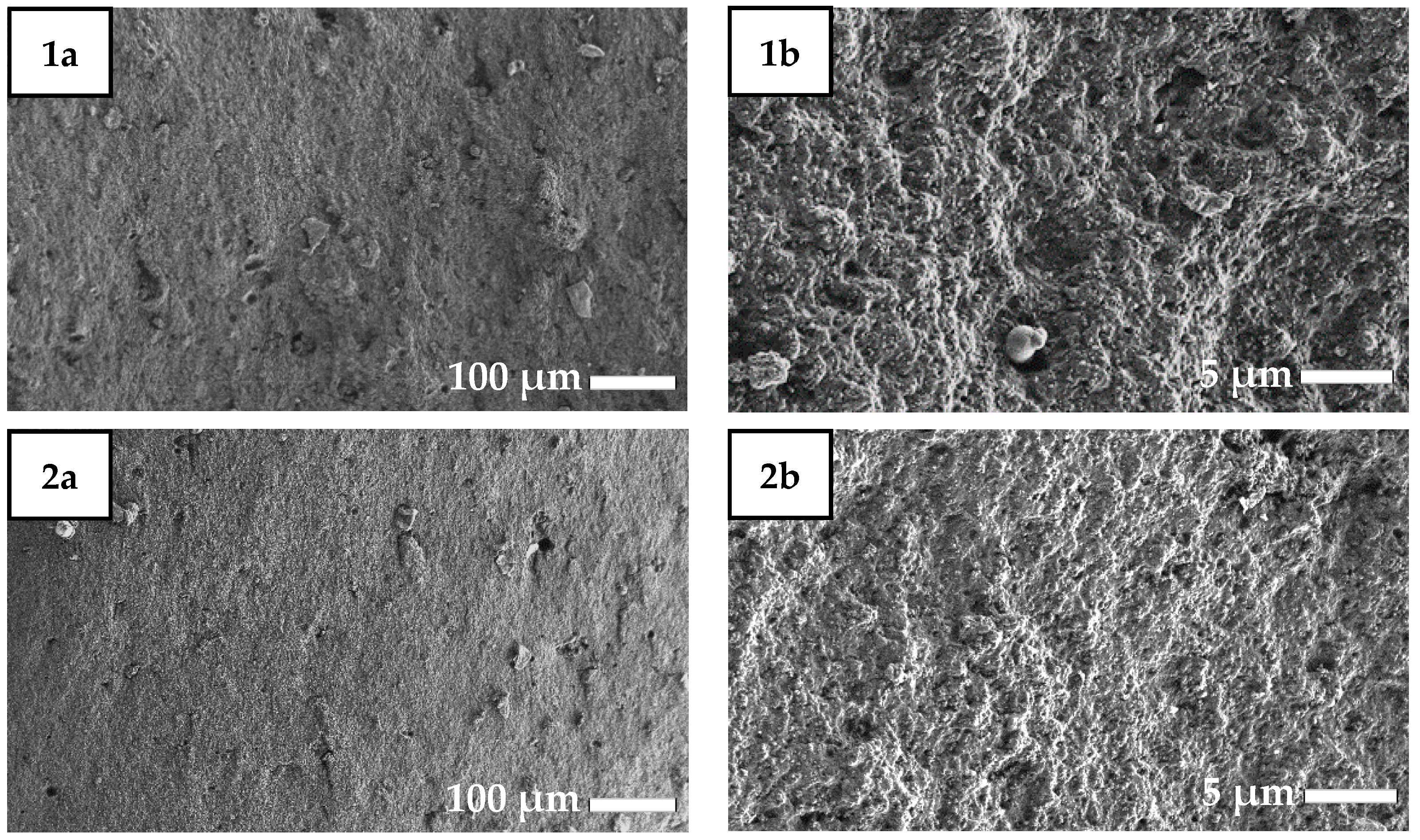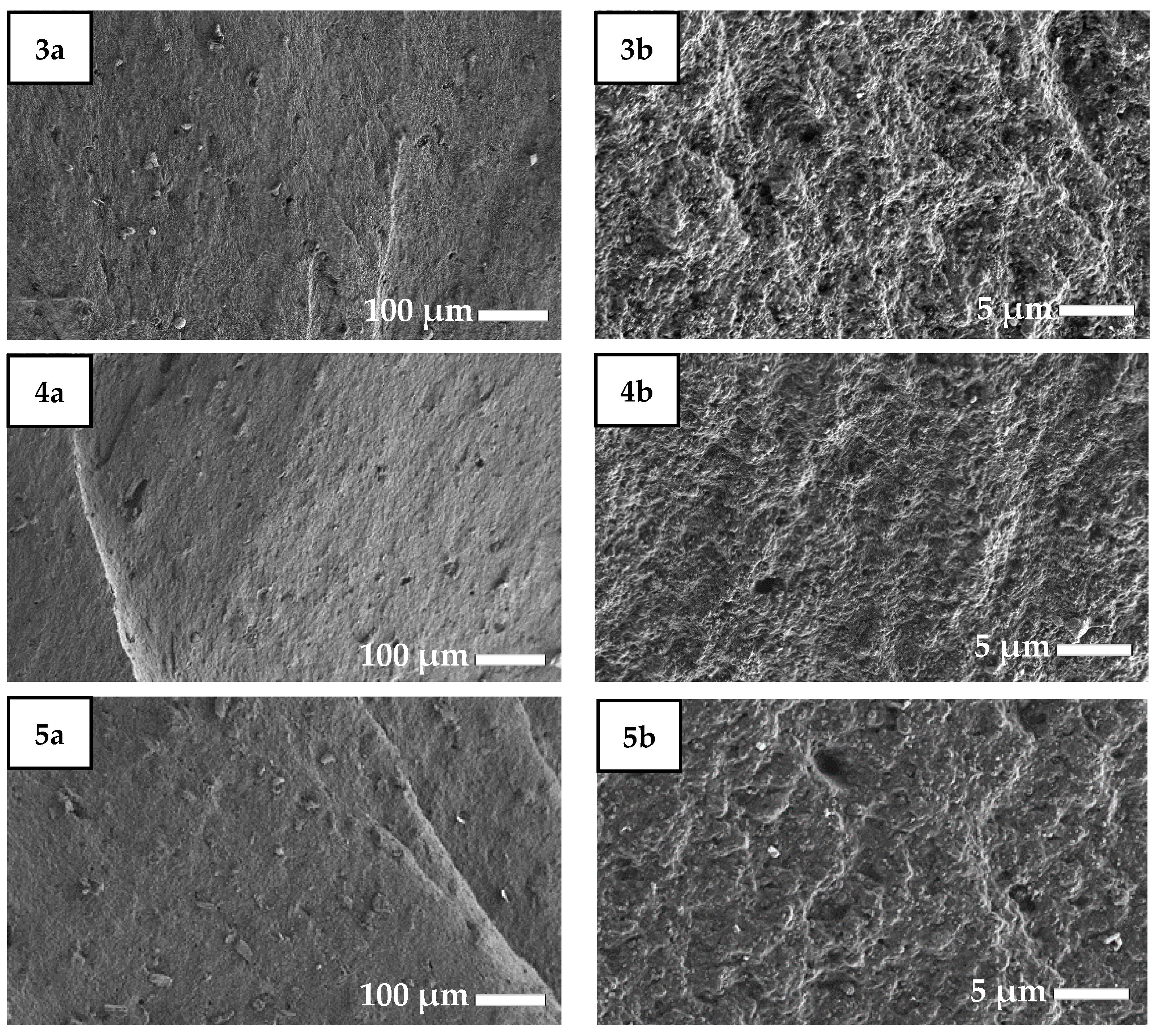Enhanced Physical and Mechanical Properties of Nitrile-Butadiene Rubber Composites with N-Cetylpyridinium Bromide-Carbon Black
Abstract
1. Introduction
2. Results and Discussion
3. Materials and Methods
4. Conclusions
Author Contributions
Funding
Institutional Review Board Statement
Informed Consent Statement
Data Availability Statement
Conflicts of Interest
Sample Availability
References
- Klingender, R.C. Acrylonitrile Butadiene Rubber. In Specialty Elastomers; Klingender, R.C., Ed.; CRC Press: Boca Raton, FA, USA, 2008; pp. 39–92. ISBN 978-1-57444-676-0. [Google Scholar]
- Degrange, J.-M.; Thomine, M.; Kapsa, P.H.; Pelletier, J.M.; Chazeau, L.; Vigier, G.; Dudragne, G.; Guerbé, L. Influence of viscoelasticity on the tribological behaviour of carbon black filled nitrile rubber (NBR) for lip seal application. Wear 2005, 259, 684–692. [Google Scholar] [CrossRef]
- Papkov, V.N.; Yuryev, A.N. Butadiene nitrile rubbers. In Handbook of Rubber Technologist; Reznichenko, S.V., Morozov, Y.L., Eds.; Izdatelskii Tsentr “Tekhinform” MAI: Moscow, Russia, 2012; Volume 1, pp. 186–210. ISBN 978-5-89551-023-0. [Google Scholar]
- Laube, S.; Monthey, S.; Wang, M.-J. Compounding with carbon black and oil. In Rubber Technology: Compounding and Testing for Performance; Dick, J.S., Ed.; Hanser Publishers: Munich, Germany, 2001; pp. 297–343. ISBN 978-3446191860. [Google Scholar]
- Wu, Y.; Wen, S.; Shen, J.; Jiang, J.; Hu, S.; Zhang, L.; Liu, L. Improved dynamic properties of natural rubber filled with irradiation-modified carbon black. Radiat. Phys. Chem. 2015, 111, 91–97. [Google Scholar] [CrossRef]
- Park, S.-J.; Kim, J.-S. Role of Chemically Modified Carbon Black Surfaces in Enhancing Interfacial Adhesion between Carbon Black and Rubber in a Composite System. J. Colloid Interface Sci. 2000, 232, 311–316. [Google Scholar] [CrossRef] [PubMed]
- Akovali, G.; Ulkem, I. Some performance characteristics of plasma surface modified carbon black in the (SBR) matrix. Polymer 1999, 40, 7417–7422. [Google Scholar] [CrossRef]
- Shadrinov, N.V.; Kapitonov, E.A.; Sokolova, M.D.; Okhlopkova, A.A.; Shim, E.L.; Cho, J.-H. Effect of Carbon Black Activation on Physicomechanical Properties of Butadiene-nitrile Rubber. Bull. Korean Chem. Soc. 2014, 35, 2891–2894. [Google Scholar] [CrossRef][Green Version]
- Gunewardena, J.; Anoma, G.S.G. Development and Evaluation of Dispersing Agents for Carbon Black Filled Natural Rubber Compounds. Ph.D. Thesis, Loughborough University, London, UK, 1999. [Google Scholar]
- Mahdi, M.S. Cationic Surfactants in Rubber Compounding. Ph.D. Thesis, Loughborough University, London, UK, 1984. [Google Scholar]
- Insarova, G.V. The Effect of Surfactants on the Processing of Rubber Compounds and Properties of Vulcanizates; TsNIITEneftekhim: Moscow, Russia, 1980; pp. 9–23. ISSN 0202-2788. [Google Scholar]
- Yamamoto, K.; Ikeda, K.; Fukuyama, M. Rubber Compositions for Sponge Rubber. U.S. Patent 5,462,975, 31 October 1995. [Google Scholar]
- Okhlopkova, T.A.; Borisova, R.V.; Nikiforov, L.A.; Spiridonov, A.M.; Okhlopkova, A.A.; Jeong, D.-Y.; Cho, J.-H. Supramolecular Structure and Mechanical Characteristics of Ultrahigh-Molecular-Weight Polyethylene–Inorganic Nanoparticle Nanocomposites. Bull. Korean Chem. Soc. 2016, 37, 439–444. [Google Scholar] [CrossRef]
- Contescu, C.I.; Burchell, D.I. Selection and Characterization of Carbon Black and Surfactants for Development of Small Scale Uranium Oxicarbide Kernels; ORNL: Oak Ridge, TN, USA, 2005; pp. 1–55. [Google Scholar]
- Richardson, S.M. The Adsorption of Mixed Surfactant Systems on Colloidal Carbon Black. Master’s Thesis, Queen’s University, Kingston, ON, Canada, 1997. [Google Scholar]
- Malkin, A.I. Regularities and Mechanisms of the Rehbinder’s Effect. Colloid J. 2012, 74, 223–238. [Google Scholar] [CrossRef]
- Borisov, V.I. The Mechanism of Action of Zn-Salts of Fatty Acids in the Vulcanization of Rubbers. Ph.D. Thesis, Moscow State University of Fine Chemical Technologies, Moscow, Russia, 1980. [Google Scholar]
- Karásek, L.; Sumita, M. Characterization of dispersion state of filler and polymer-filler interactions in rubber-carbon black composites. J. Mater. Sci. 1996, 31, 281–289. [Google Scholar]
- Donnet, J.-B.; Custodero, E. Reinforcement of Elastomers by Particulate Fillers. In Science and Technology of Rubber, 3rd ed.; Mark, E.J., Erman, B., Eirich, F.R., Eds.; Elsevier Academic Press: Burlington, ON, Canada, 2005; pp. 367–400. [Google Scholar]
- Muhr, A.H.; Roberts, A.D. Rubber abrasion and wear. Wear 1992, 158, 213–228. [Google Scholar] [CrossRef]
- El-Tayeb, N.S.M.; Nasir, R.M. Effect of soft carbon black on tribology of deproteinized and polyisoprene rubbers. Wear 2007, 262, 350–361. [Google Scholar] [CrossRef]
- Golubkova, G.V.; Lomovsky, O.I.; Vlasov, A.A.; Davliova, L.S.; Belyaev, E.Y.; Malakhov, V.V. Studies of X-ray amorphous phase in mechanochemical synthesis of iron silicides from elements. J. Alloys Compd. 2000, 307, 131–136. [Google Scholar] [CrossRef]
- Baikalova, Y.V.; Lomovsky, O.I. Solid state synthesis of tungsten carbide in an inert copper matrix. J. Alloys Compd. 2000, 297, 87–91. [Google Scholar] [CrossRef]
- Belyaev, E.; Mamylov, S.; Lomovsky, O. Mechanochemical synthesis and properties of thermoelectric material β-FeSi2. J. Mater. Sci. 2000, 35, 2029–2035. [Google Scholar] [CrossRef]
- Koshelev, F.F.; Kornev, A.E.; Bukanov, A.M. The General Technology of Rubber, 4th ed.; Khimiya: Moscow, Russia, 1978; pp. 72–76. [Google Scholar]
- GOST 270–84 State Standard, Rubber: Method of the Determination Elastic and Tensile Stress–Strain Properties. Available online: http://vsegost.com/Catalog/21/21850.shtml (accessed on 23 January 2020).
- GOST 9.030-74 State Standard, Unified System of Corrosion and Aging Protection—Vulcanized Rubbers: Method of Testing Resistance to Attack by Corrosive Media in Limp State. Available online: http://vsegost.com/Catalog/35/3586.shtml (accessed on 23 January 2020).




| Properties | 1 | 2 | 3 | 4 | 5 |
|---|---|---|---|---|---|
| Tmax (kPa) | 1627 | 2244 | 2362 | 2444 | 1436 |
| Tmin (kPa) | 310 | 302 | 305 | 302 | 263 |
| ΔT (kPa) | 1317 | 1942 | 2057 | 2142 | 1173 |
| t2 (min) | 0.68 | 0.32 | 0.28 | 0.26 | 0.76 |
| t90 (min) | 12.19 | 8.49 | 6.07 | 5.06 | 11.32 |
| t90 − t2 (min) | 11.51 | 8.17 | 5.79 | 4.80 | 10.56 |
| CRI (min−1) | 8.69 | 12.24 | 17.27 | 20.83 | 9.47 |
| fP (MPa) | 7.8 ± 0.5 | 17.5 ± 1.1 | 13.1 ± 0.8 | 11.4 ± 0.7 | 6.9 ± 0.4 |
| f100 (MPa) | 2.1 ± 0.1 | 4.9 ± 0.3 | 5.6 ± 0.3 | 5.1 ± 0.3 | 1.7 ± 0.1 |
| εp (%) | 464 ± 29 | 306 ± 20 | 227 ± 14 | 203 ± 13 | 495 ± 30 |
| Q (%) | 9.69 ± 0.30 | 8.97 ± 0.28 | 8.42 ± 0.26 | 8.87 ± 0.27 | 9.51 ± 0.30 |
| Shore A | 68 ± 2 | 78 ± 2 | 79 ± 2 | 80 ± 3 | 68 ± 1 |
| Compounds | 1 | 2 | 3 | 4 | 5 |
|---|---|---|---|---|---|
| BNKS-18 base rubber | 108 | 108 | 108 | 108 | 108 |
| Carbon black N550 | 50 | 45 | 40 | 35 | - |
| Activated carbon black N550 | - | - | - | - | 50 |
| CPB-modified-carbon black N550 (CPB-CB) | 0 | 5 | 10 | 15 | 0 |
Publisher’s Note: MDPI stays neutral with regard to jurisdictional claims in published maps and institutional affiliations. |
© 2021 by the authors. Licensee MDPI, Basel, Switzerland. This article is an open access article distributed under the terms and conditions of the Creative Commons Attribution (CC BY) license (http://creativecommons.org/licenses/by/4.0/).
Share and Cite
Kapitonov, E.A.; Petrova, N.N.; Mukhin, V.V.; Nikiforov, L.A.; Gogolev, V.D.; Shim, E.L.; Okhlopkova, A.A.; Cho, J.-H. Enhanced Physical and Mechanical Properties of Nitrile-Butadiene Rubber Composites with N-Cetylpyridinium Bromide-Carbon Black. Molecules 2021, 26, 805. https://doi.org/10.3390/molecules26040805
Kapitonov EA, Petrova NN, Mukhin VV, Nikiforov LA, Gogolev VD, Shim EL, Okhlopkova AA, Cho J-H. Enhanced Physical and Mechanical Properties of Nitrile-Butadiene Rubber Composites with N-Cetylpyridinium Bromide-Carbon Black. Molecules. 2021; 26(4):805. https://doi.org/10.3390/molecules26040805
Chicago/Turabian StyleKapitonov, Egor A., Natalia N. Petrova, Vasilii V. Mukhin, Leonid A. Nikiforov, Vladimir D. Gogolev, Ee Le Shim, Aitalina A. Okhlopkova, and Jin-Ho Cho. 2021. "Enhanced Physical and Mechanical Properties of Nitrile-Butadiene Rubber Composites with N-Cetylpyridinium Bromide-Carbon Black" Molecules 26, no. 4: 805. https://doi.org/10.3390/molecules26040805
APA StyleKapitonov, E. A., Petrova, N. N., Mukhin, V. V., Nikiforov, L. A., Gogolev, V. D., Shim, E. L., Okhlopkova, A. A., & Cho, J.-H. (2021). Enhanced Physical and Mechanical Properties of Nitrile-Butadiene Rubber Composites with N-Cetylpyridinium Bromide-Carbon Black. Molecules, 26(4), 805. https://doi.org/10.3390/molecules26040805






